1/2 x .025 700
1/2 x .015 420
1/2 x .030 850
available and satisfactory in many
1/2 x .020 560
5/8 x .020 700
1/2 x .025 700
5/8 x .025 870
instances. Figure D-4 provides
1/2 x .030 900
5/8 x .030 1,060
Note: See ASTM D3950, Standard Specifications for Strapping, Nonmetallic (and specifications for nonmetallic
Joining Methods), for additional information on nonmetallic materials and equipment.
strapping material.
Figure D-4.
Specifications for Nonmetallic
Strapping Materials
D-8.
INFLATABLE AIR
BAGS. Inflatable air bags are
available in paper or rubber and may
be reusable or disposable. Inflatables
are used for light- and medium-duty
bracing. Inflatables are not used to
prevent cargo from moving when
subjected to impacts such as those
resulting from rail car couplings.
Inflatables are mostly intended to be
a void filler which offers added
protection to containerized cargo. If
the cargo facing the inflatable
dunnage is of such a nature that it
may cause perforations, use
cushioned puncture resistant material
between the cargo and the dunnage.
Figure D-5 shows an inflatable air
bag used in a container.
Figure D-5.
Inflatable Air Bags Used to
Brace Cargo
D-6
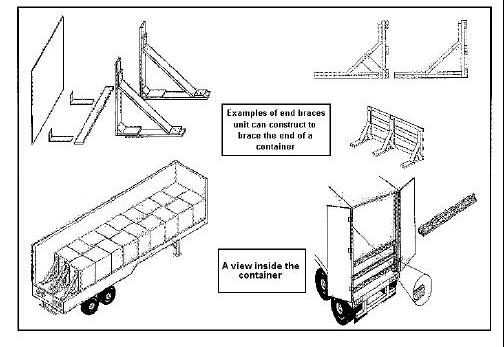
FM 55-80
D-9.
FIBERBOARD. Fiberboard is available in sheets, rolls, and pre-scored structural shapes for light-duty bracing applications. It functions as a divider, deck, or partition. When using fiberboard or similar materials, the strength and resistance to moisture must be satisfied. When loaded containers are transported over long distances, temperature changes occur, particularly during the winter. This results in the condensation of water vapor. The fiberboard delaminates, losing its structural stability. Corrugated fiberboard also has poor resiliency. Once it is compressed, the material does not expand to its prior shape and thus creates a void. As a result, cargo blocking, bracing, and protection no longer exist.
D-10.
MISCELLANEOUS DUNNAGE MATERIAL. The above list of dunnage materials is not all inclusive. There are many additional devices and dunnage systems available to hold and secure cargo from movement while in transit. Some of these systems are designed for specific kinds of cargoes while others apply to cargo in general. Dunnage bags filled with polystyrene pieces can be used to absorb shock and secure products against impact and shifting. Laminated strapped bulkheads have been successfully used in securing drum cargo and other freight in rail cars, trailers, and dry-cargo containers. Used motor vehicle tires, metal frames, pallets, various plastic products, and nets have been successfully used as dunnage.
When obtaining blocking and bracing dunnage for the loading operations, it is recommended that you first see what is available at your plant or loading facility. Often, the material necessary to properly secure the cargo in the container is readily available as waste material or by products.
Figure D-6 and Figure D-7, page D-8, show some options for blocking and bracing the end of the container.
Figure D-6. Examples of End Bracing
D-7

FM 55-80
Always Use Solid Rear Bracing
Honeycomb Corrugated Dunnage
Figure D-7. Solid Rear Bracing
D-11.
NAILS/NAILING. Nails must be adequate in size and number when wood blocking, bracing, and anchor plates are used to secure the cargo in the containers. When the floor of the container is used, the nails should penetrate a minimum of two thirds of the floor’s thickness. Nails must not be too large and should be used in a staggered pattern. This will avoid splitting the lumber.
The floor boards in a general-purpose dry-freight container on the average are 1 1/8 inches thick. The size of lumber used for bracing and securing the load will determine the length of the nails to be used. Figure D-8 shows proper nailing techniques and the sizes of various common nails.
D-12.
STOWING AND SECURING FOR SPECIFIC CARGO. Paragraphs D-13 through D-18 address typical commodities shipped in containers which have unique shipping requirements with respect to their loading configurations.
D-13.
BAGGED CARGO. A large number of commodities are packed for shipment in bags.
Typical commodities are sugar, coffee, grain, flour, cement, plastics, and chemicals. Methods for stowing bags vary. Several factors are involved: the size and quantity of the bags, the nature and condition of the contents, and the requirements of the commodity as to ventilation.
Bagged commodities are likely to be damaged if stowed close to moist cargo or cargo giving off large concentrations of moisture. Do not containerize moisture-sensitive cargo in the same container with moisture-emitting cargo. Use a ventilated container when stowing bagged cargo which is sensitive to moisture or sweat damage. If cargo is susceptible to moisture damage, coordinate loading to reduce the time bagged cargo has to be in the containers. If possible, stow bagged cargo just before sailing. Never use hooks on bagged commodities.
D-8
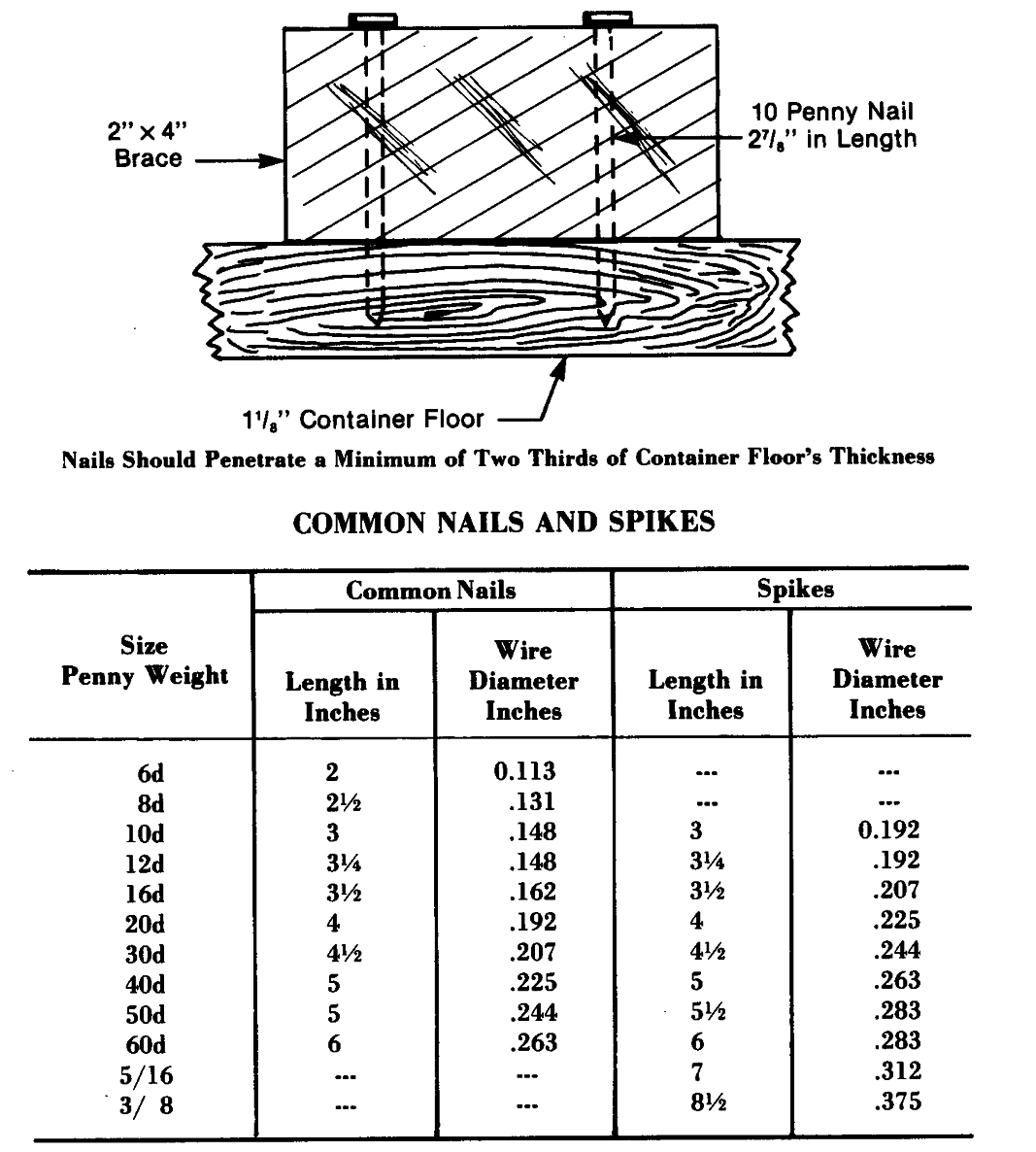
FM 55-80
2”x 4
Brace
10 Penny Nail
Nails Should Penetrate a
2 7/8” in Length
Minimum of Two-Thirds of
Container Floor’s Thickness
1 1/8” Container Floor
COMMON NAILS AND SPIKES
Common Nails
Spikes
Wire
Wire
Size
Length in
Diameter
Length in
Diameter
Penny Weight
Inches
Inches
Inches
Inches
6d
2
0.113
…
…
8d
2 1/2
.131
…
…
10d
3
.148
3
0.192
12d
3 1/4
.148
3 1/4
.192
16d
3 1/2
.162
3 1/2
.207
20d
4
.192
4
.225
30d
4 1/2
.207
4 1/2
.244
40d
5
.225
5
.263
50d
5
.244
5 1/2
.283
60d
6
.263
6
.283
5/16
…
…
7
.312
3/8
...
...
8 1/2
.375
Figure D-8.
Nailing Technique and Common Nail Sizes
Protect bags from direct contact with other cargo and with the container floor, wall, and roof structures. Dunnage material such as waterproofed paper or fiberboard should be laid on the floor of the container before loading. Place it between the walls of the container and the cargo as well as at the top of the load. Dunnage of this kind will decrease chances of damage from either salt or fresh water. It will protect cargo from rough or sharp edges and will lessen chances of penetration of dirt or other contaminants.
When you stow more than one kind of cargo on top of one another (for example, flour on top of grain), separate each commodity from the other with waterproofed paper or a similar product.
This will prevent spillage of materials from torn bags from mixing with cargo below. Use partitions when bagged cargo is stowed either on top or below other general dry cargo. This is shown in Figure D-9, page D-10.
Bagged cargo can be stowed in a variety of positions. The method of tiering depends largely upon the commodity being carried. If the commodity is one for which all possible ventilation is required, stow bags one on top of the other lengthwise with the ends well butted.
Bagged goods may also be stowed in a container in a lateral position. Place the long axis across the container. Goods stowed in this fashion have a tendency to shift fore and aft. If not braced properly, container damage could result, especially at the doors. Employ proper rear bracing to prevent bags from falling out when the container is opened.
D-9
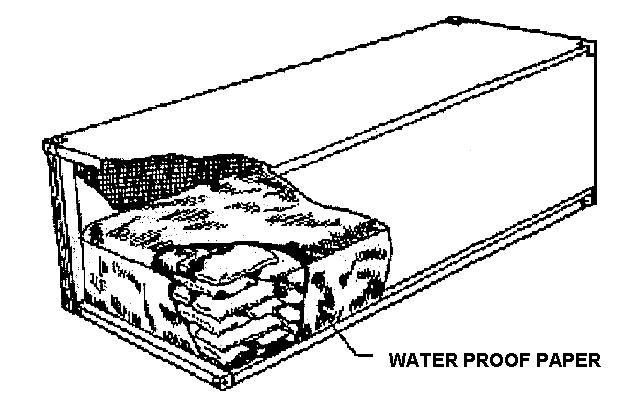
FM 55-80
Figure D-9. Waterproofed Paper Used to Separate Commodities In most cases, when loading bagged cargo (other than palletized), use the “cross-tier” or
“lateral” method as show in Figure D-10. These methods are recommended in order to reduce pressure on the sides and ends of the container and also to unitize surface friction against the bottom.
The “cross-tier” method is accomplished by alternating the direction in which the successive tiers are laid. In this manner each tier binds the tier below it and the whole block is formed into a unit. When stuffing bagged cargo do the following:
• Container floor should be clean and free of protruding nails and screws.
• Bags should be loaded in a combination length and crosswise manner.
• Rear tier should be interlocked in a tight stow so that when rear doors are opened, bags will not fall out.
D-14.
BALED CARGO. Many manufactured materials are packed in burlap or other bales for ocean shipment. These materials include cotton piece goods, fine textile goods, and raw materials such as cotton, wool, and leather. Almost any compressible commodity can be baled and shipped.
Of course, many articles are not suitable for baling. Consequently, only commodities which will stand compression should be baled.
Baled cargo is especially liable to damage from chafing and moisture. To prevent chafing, bales should be carefully dunnaged and blocked to prevent movement. When stowing baled cargo, give special attention to preventing metal bands from rubbing against each other or against the metal portions of the container. This could be a potential fire hazard, especially when the bales consist of rags, waste paper, fiber, or similar flammable products. To avoid concentrations of moisture, use a ventilated dry-cargo container. For some commodities, loaders should take precautions to avoid cargo staining and water damage. Place sufficient dunnage to raise the goods off the floor. This will protect the cargo by allowing water and moisture to settle between the dunnage and not come in D-10
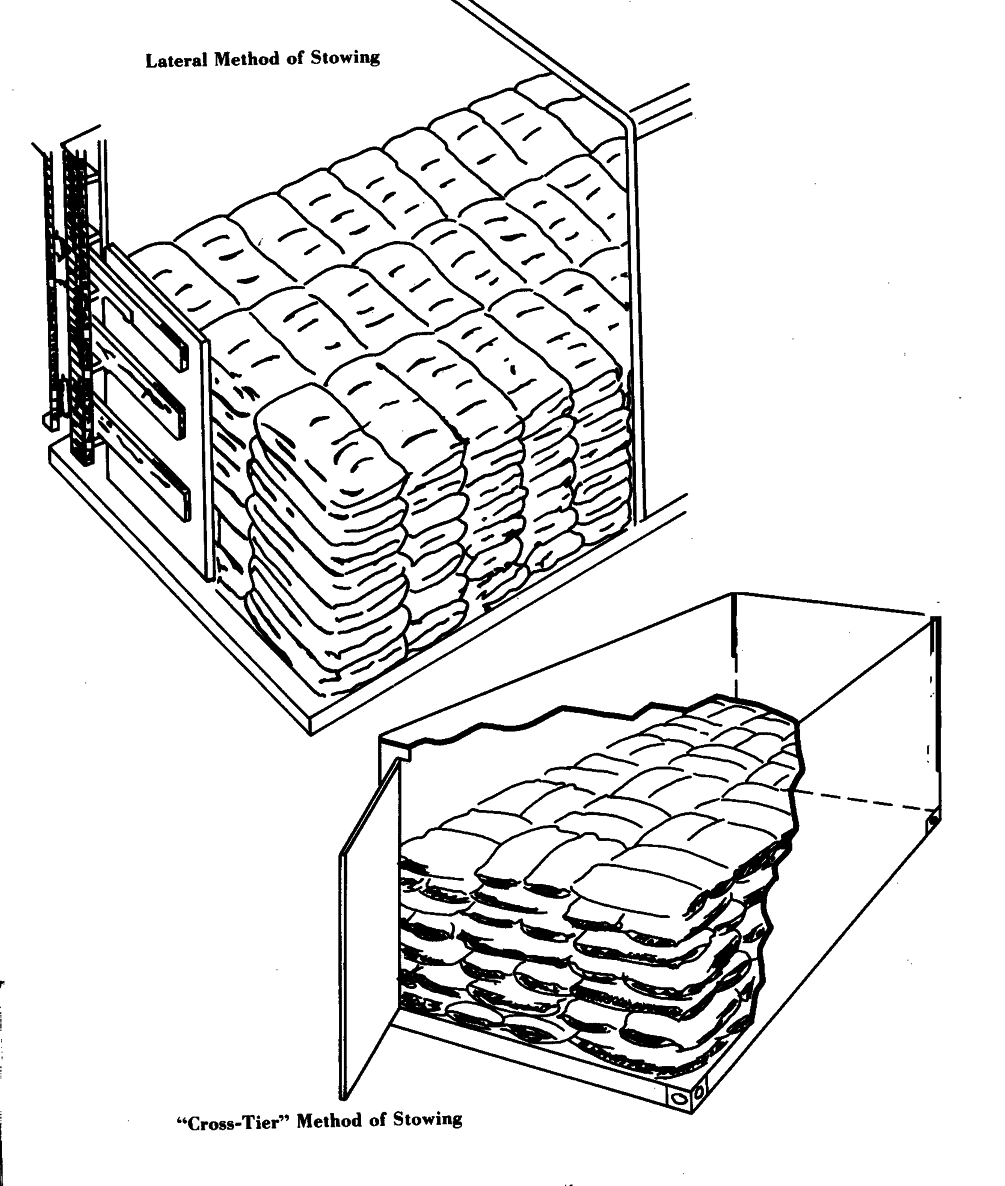
FM 55-80
direct contact with the bales. To further protect the goods, a layer of waterproof paper or similar material should be laid over the floor and dunnage before loading. This is especially recommended if the commodity is of a finished nature such as fine textile goods. Plastic or water-repellent shrouds should always be placed over the top and sides of the load regardless of the commodity. This is done to protect against damage from condensation. Under no condition should cargo hooks be used on baled commodities of any kind.
The size of the bales varies considerably even among similar commodities. The most economical bale is twice as long as it is wide. The third dimension should be equal to or greater than the width. However, this is not always the case. The size of the bale will determine the best container loading pattern. Baled cargo, like bagged goods, should be stowed using the “cross-tier”
method when the dimensional characteristics allow (see paragraph D-13).
Lateral Method of Stowing
“Cross-Tier” Method of Stowing
Figure D-10. Lateral and Cross-Tier Stowing Methods
Baled goods must lie flush against the sides of the container. If they do not, voids will exist between the bales. Wedge dunnage materials (rolled-up corrugated fiberboard, polyurethane slabs, and so forth) between the bales when loading to prevent movement and chafing.
Figure D-11, page D-12, shows the proper way to load baled goods in a container.
To stack and brace baled cargo, a platform can be constructed using wood dunnage material or pallets. It should be constructed so the lower bales will butt against at least one-third the height of the upper bales.
D-11

FM 55-80
Figure D-11. Stacking and Bracing Baled Cargo
D-15.
BARRELS AND DRUMS. Barrels and drums made of metal (such as sheet steel, aluminum, stainless steel, and so forth) are used for the shipping of many commodities. The sheet or body of the drum is usually made of a single sheet of metal with the seam welded or brazed. The components of a drum are shown in Figure D-12, page D-14.
Metal drums are used extensively for shipping such products as acids, greases, lubricants, paints, pastes, pigments, powders, printing inks, red lead, varnishes, certain food products, and similar solids, semisolids, and liquids.
There are three general classes of metal drums, divided according to the weight or gauge of metal from which the drums are made. These classes are:
• Drums made of very heavy metal (16- up to 12-gauge).
• Drums made of light-gauge metal (generally 20- up to 18-gauge).
• Drums made of very light metal (from 28- to 22-gauge).
The latter two classes are generally considered suitable for only one shipment and are designated “one-time shippers” or “single-trip units”. All such drums manufactured under DOT
specifications are embossed with the letters STC, single-trip containers, and they may be used only once for the transportation of the dangerous articles for which they are authorized. However, such drums may be reused for the transportation of commodities which are not classified as dangerous, provided the drum itself complies with the requirements. Because of the light gauge and D-12
FM 55-80
construction, it is not always economical to do so, and their use should be restricted generally to the one-time shipment.
When dealing with drummed cargo, one of the primary considerations is proper selection of the size, gauge, and style of drum to transport the product as specific commodities are governed by strict regulations as well as the type of drum to be used. This is very important not only for dangerous goods but for all classes of merchandise shipped in drums. One of the major causes of damage to drummed cargo is incorrect selection of the type drum best suited to transport the goods.
Keep the following points in mind when stowing drummed cargo in containers:
• Always stow upright.
• Stow drums with bungs uppermost if the bung or closure is at one end.
• Always stow drums with bungs on top.
• Do not re-use single- or one-trip drums. Second-hand drums, unless thoroughly reconditioned and tested, may give trouble either because of dents at the chine or because of previous wear and tear at the closures.
• Use adequate seals on locking levers and sealing rings of open-end drums. Failure of seals may result in accidental opening of covers.
• Be sure the drums are approved for hazardous cargo.
• Do not overload. Drummed cargo tends to be very dense. Be sure the weight of the cargo and dunnage does not exceed the container weight capacity and over-the-road limitations.
• Inspect drums thoroughly before loading. Any drums showing signs of leakage should not be shipped.
• Attach special instructions concerning handling of drums and contents to the container.
Pre-plan the type of stowage pattern, especially if risers are requested. Risers are used to elevate alternate rows of drums to reduce chafing and damage to the drum and drum lid through vibration. Risers are most frequently used with drums having rolling hoops. The elevation of rows will not only reduce the contact of rolling hoops, but will also provide for a tighter stow.
The average internal width of a dry-cargo container is 92 inches. This is important to remember when preplanning the stow. This is especially important if the party stowing the containers is also the one who is responsible for purchasing the drums. For example, to obtain a maximum floor load, the diameter of the drums must be divisible by the internal width of the container with little or no leftover space.
Most drums have rolling hoops. These hoops provide good surface contact when rolling the drums in a horizontal position. The hoops also add strength to the construction of the drum. Hoops are very susceptible to rupture due to friction between drums and dunnage. A material such as fiberboard must be positioned between drums to prevent damage. Rolling hoops also add considerable thickness to the outside dimension of drums.
These additional inches may inhibit maximum container loading. To reduce these added inches and lessen the chances of friction damage, raise alternate rows of drums a few inches by placing longitudinal of horizontal lumber on the floor. This will allow the rolling hoops to ride clear of each other.
D-13
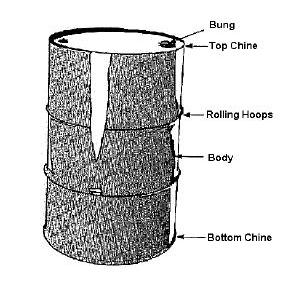
FM 55-80
To get a maximum stowage pattern, divide the internal width of the container by the diameter of the drums. If the remaining is 0.732 of the drum diameter or greater, the stowage pattern to obtain maximum stowage can be increased by using dunnage to raise every other drum high enough to effectively reduce the overall diameter space needed to place more drums side-by-side. Apply the following process to make this determination: Assume the drum’s diameter is 24 inches. Dividing 92 (which is the internal width of the container) by 24 = 3.833. At least three drums can be placed side by side, since the remainder is more than 0.732, the space can be worked with to achieve better use of space. If these drums have rolling hoops, it may be possible to load four drums across by raising alternate rows to reduce the effective diameter.
When loading a general-purpose container, position each drum to reduce voids. Drums should be placed upright with the bungs on top and packed tightly. When drums are palletized, they may be secured to the pallet.
When loading drums in a general-purpose container, load them one high and bind them together to create a solid unitized load. Any general cargo which may be available should be stowed on top; otherwise, drums can be loaded two high.
Double tiered loading must always start at the front or nose of the container opposite the doors. In all cases, the bottom tier should be stowed as close to the rear of the container as possible and regardless of the amount of void space, suitable rear bracing must be installed.
There are a number of methods employed when double tiering drums. Before you load, place a vertical timber at each front corner of the container. The timber should be long enough to fit from floor to overhead.
D-14

FM 55-80
Figure D-12. Components of a Drum
Figure D-13 shows alternative ways to stack drums in a container.
Figure D-13. Methods of Nesting and Double Stacking Drums Wood dunnage or plywood (minimum 3/8-inch) must be laid on top of the drums of the bottom tier. Pass cargo securing bands around the forward uprights and the drums in the second tier and firmly secure. Place vertical timbers under the bands across the end of the drums to hold them in position in the event of slack. Use staples on the timbers to keep them from slipping down. Nail cross piece, heeled against the bottom of the drums, lengthwise to dunnage if timber is employed between tiers.
Handle pails and fiber drums much the same as regular drums. However, most pails have ridged interlocking chines. When double stacking, dunnage should not be used if the bottom and top rims can interlock. When loading and securing fiber drums, care must be taken not to cut into the drums.
D-16.
CARTONS, CASES, AND BOXES. In a general cargo of miscellaneous goods, there is usually a varied assortment of lightweight wooden boxes, cases, and fiberboard cartons of many sizes, weights, and types of construction. Proper stowage of the packages obviously requires careful planning, skillful placing, and good blocking and bracing.
Lightweight cartons of uniform fiberboard pack are probably the easiest of all the different types of cargo to stow. If the cartons are not securely braced, the loads may shift in transit. There is a good chance that some of the cartons in the first two or three tiers will fall out when the doors of the containers are opened. This could cause cargo damage and possible injury to personnel.
D-15
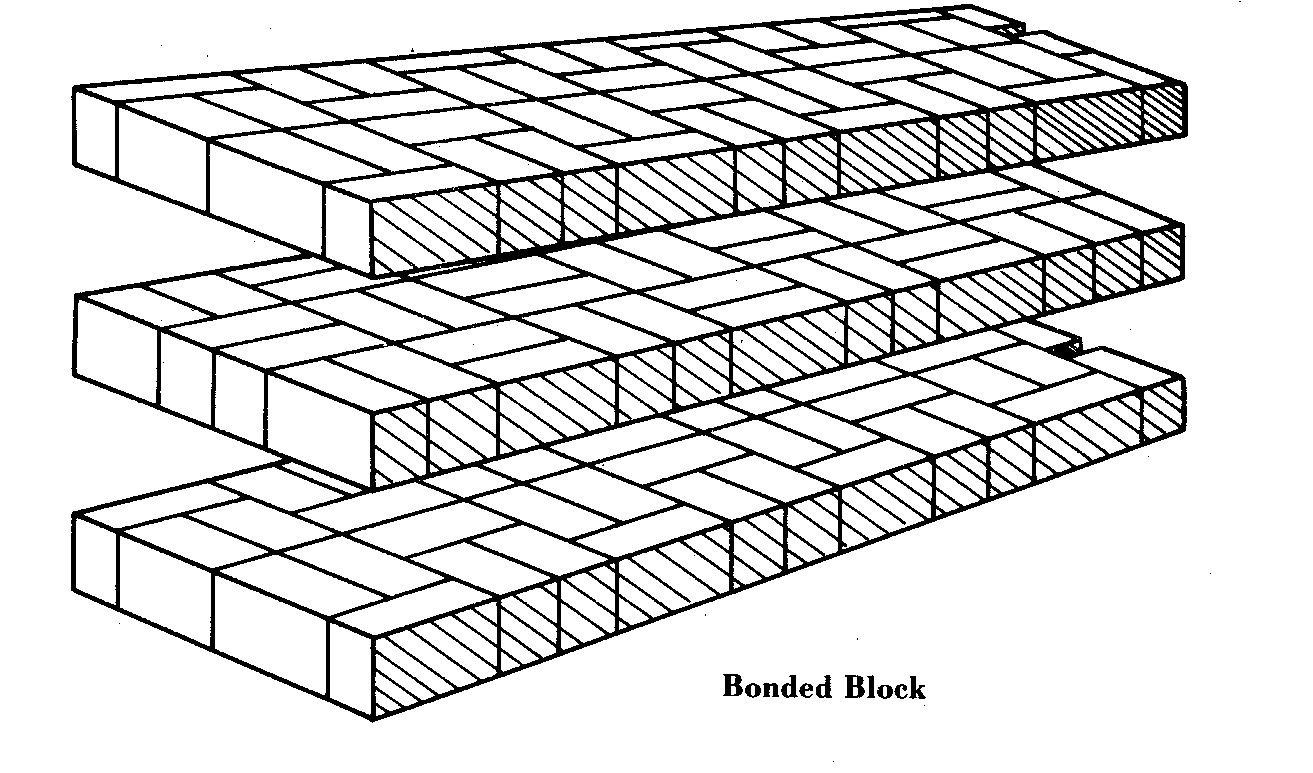
FM 55-80
The “bonded block” method of stowing shown in Figure D-14 is recommended for boxes containing tightly packed, dense items which support the sides and ends of the pack as each tier binds the tier below it and a whole block is formed into a unit.
Figure D-14. Bonded Block
Fiberboard boxes containing lightweight or fragile items which provide little or no support to the box surfaces should be stowed by stacking directly one atop the other, keeping gummed flaps uppermost for greatest strength advantage. Always obey label markings (such as, “This Side Up,”
or “Fragile”).
Different size cartons, cases, and boxes may often be stowed in the same container. When loading and securing under these conditions, keep similar style packages together and use dividers to segregate the different types. The dividers may be plywood or fiberboard sheets.
When packages do not completely fill the internal container dimensions, load the cargo applying an offset pattern and fill all voids to prevent the goods from moving. Under normal conditions, rolled-corrugated fiberboard or similar material makes an excellent filler.
In most instances the uppermost tier will be incomplete and a plywood barrier or dividers may be used to secure these pieces. If the load does not fully use the entire length of the container, the cargo must be secured and a bulkhead constructed at the rear of the load to prevent fore and aft movement.
Always provide plastic or water-repellent shrouds over the top and sides of the cargo to protect it against water damage. Suitable dunnage or pallets may also be placed on the container floor to provide a sump area protecting the lower tiers from moisture build up or water which may enter the container.
D-16
FM 55-80
In all instances, a rear barrier should be constructed when the cargo does not fill out the entire length of the container depending on the nature of cargo stow. Rear barriers prevent top-tier cargo from falling out once the doors are open. Never stow heavy goods on top of light goods.
Place the heavier items on the bottom and the lighter ones on top.
D-17.
WOOD BOXES AND CRATES. Stack boxes or crates of uniform large size and weight directly on top of each other. All void areas must be filled at the top, sides, or ends by the use of partitions or fillers. If large voids are present, block, brace, and tie down the cargo to prevent movement in any direction. When loading groups of crates or boxes of different weights or dimensions, separate each group by partitions, dividers, or auxiliary decking. If this is not possible, place the heavy, dense items on the bottom and the lighter pieces on top. Take care that any concentrated weights in the upper tier are evenly distributed. This is especially applicable when it becomes necessary to stow units of smaller base dimensions over larger ones. When applying bracing material, it is very important that only the strength members of the boxes and crates are used and not the weak points, panels, or sheathing.
D-18.
PALLETIZED/UNITIZED CARGO. When you consider alternatives in order to reduce the overall physical distribution costs, palletization and unitization must be considered. These systems can accommodate many products. They can mean faster handling, ease of storage, and greater cargo protection.
Pallets are horizontal platform devices used as a base for assembling, storing, and handling goods in a unit load. They can be made from wood, metal, fiberboard, plastics, or a combination of these materials. Unitization may be defined as the assembling to one or more items assembled into a compact load, secured together, and provided with skids and cleats for ease of handling.
Palletization and unitization offer many advantages to the shipper, carrier, and consignee.
They require material-handling equipment which will reduce the normal handling damage hazard.
They also have the following advantages:
• Eliminate the multiple handling of individual items.
• Save on labor costs.
• Reduce pilferage and theft.
• Permit greater use of space.
• Reduce lost or strayed items.
• Speed loading and unloading of trailers, boxcars, intermodal containers, barges, ships, and aircraft.
• Eliminate wasteful packaging.
• Offer freight allowances granted by many steamship lines when the pallet load, shipped as a separate item, conforms to specifications.
Under normal conditions the weight of the pallet load should be limited to 3,000 pounds for non-NATO shipments and 2,500 pounds for shipments to NATO forces. Another important point which must be considered when palletizing or unitizing cargo for offshore markets is the availability of proper handling equipment at the unl












